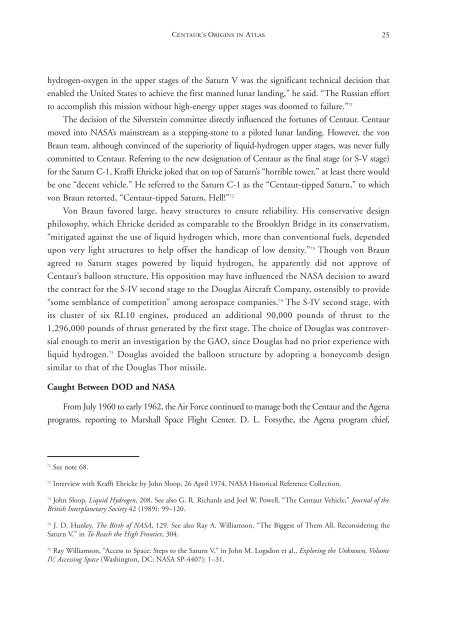Taming Liquid Hydrogen - NASA's History Office
Taming Liquid Hydrogen - NASA's History Office
Taming Liquid Hydrogen - NASA's History Office
Create successful ePaper yourself
Turn your PDF publications into a flip-book with our unique Google optimized e-Paper software.
hydrogen-oxygen in the upper stages of the Saturn V was the significant technical decision that<br />
enabled the United States to achieve the first manned lunar landing,” he said. “The Russian effort<br />
to accomplish this mission without high-energy upper stages was doomed to failure.” 71<br />
The decision of the Silverstein committee directly influenced the fortunes of Centaur. Centaur<br />
moved into NASA’s mainstream as a stepping-stone to a piloted lunar landing. However, the von<br />
Braun team, although convinced of the superiority of liquid-hydrogen upper stages, was never fully<br />
committed to Centaur. Referring to the new designation of Centaur as the final stage (or S-V stage)<br />
for the Saturn C-1, Krafft Ehricke joked that on top of Saturn’s “horrible tower,” at least there would<br />
be one “decent vehicle.” He referred to the Saturn C-1 as the “Centaur-tipped Saturn,” to which<br />
von Braun retorted, “Centaur-tipped Saturn, Hell!” 72<br />
Von Braun favored large, heavy structures to ensure reliability. His conservative design<br />
philosophy, which Ehricke derided as comparable to the Brooklyn Bridge in its conservatism,<br />
“mitigated against the use of liquid hydrogen which, more than conventional fuels, depended<br />
upon very light structures to help offset the handicap of low density.” 73 Though von Braun<br />
agreed to Saturn stages powered by liquid hydrogen, he apparently did not approve of<br />
Centaur’s balloon structure. His opposition may have influenced the NASA decision to award<br />
the contract for the S-IV second stage to the Douglas Aircraft Company, ostensibly to provide<br />
“some semblance of competition” among aerospace companies. 74 The S-IV second stage, with<br />
its cluster of six RL10 engines, produced an additional 90,000 pounds of thrust to the<br />
1,296,000 pounds of thrust generated by the first stage. The choice of Douglas was controversial<br />
enough to merit an investigation by the GAO, since Douglas had no prior experience with<br />
liquid hydrogen. 75 Douglas avoided the balloon structure by adopting a honeycomb design<br />
similar to that of the Douglas Thor missile.<br />
Caught Between DOD and NASA<br />
Centaur’s Origins in Atlas 25<br />
From July 1960 to early 1962, the Air Force continued to manage both the Centaur and the Agena<br />
programs, reporting to Marshall Space Flight Center. D. L. Forsythe, the Agena program chief,<br />
71 See note 68.<br />
72 Interview with Krafft Ehricke by John Sloop, 26 April 1974, NASA Historical Reference Collection.<br />
73 John Sloop, <strong>Liquid</strong> <strong>Hydrogen</strong>, 208. See also G. R. Richards and Joel W. Powell, “The Centaur Vehicle,” Journal of the<br />
British Interplanetary Society 42 (1989): 99–120.<br />
74 J. D. Hunley, The Birth of NASA, 129. See also Ray A. Williamson, “The Biggest of Them All, Reconsidering the<br />
Saturn V,” in To Reach the High Frontier, 304.<br />
75 Ray Williamson, “Access to Space: Steps to the Saturn V,” in John M. Logsdon et al., Exploring the Unknown, Volume<br />
IV, Accessing Space (Washington, DC: NASA SP-4407): 1–31.

















